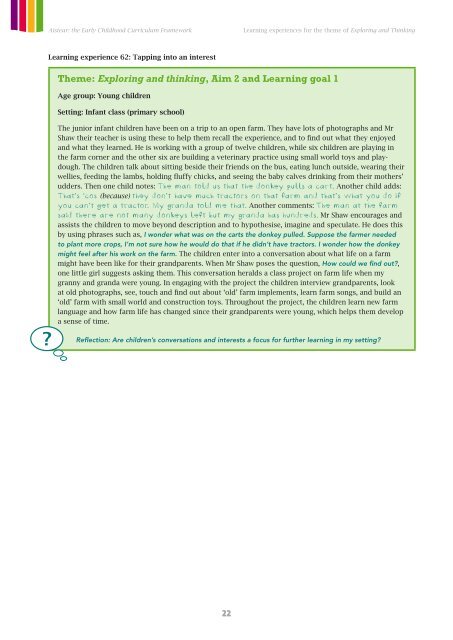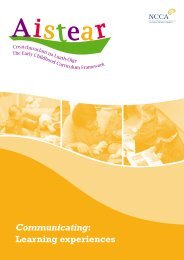Exploring and Thinking: Learning experiences
Exploring and Thinking: Learning experiences
Exploring and Thinking: Learning experiences
Create successful ePaper yourself
Turn your PDF publications into a flip-book with our unique Google optimized e-Paper software.
Aistear: the Early Childhood Curriculum Framework<br />
<strong>Learning</strong> experience 62: Tapping into an interest<br />
22<br />
<strong>Learning</strong> <strong>experiences</strong> for the theme of <strong>Exploring</strong> <strong>and</strong> <strong>Thinking</strong><br />
Theme: <strong>Exploring</strong> <strong>and</strong> thinking, Aim 2 <strong>and</strong> <strong>Learning</strong> goal 1<br />
Age group: Young children<br />
Setting: Infant class (primary school)<br />
The junior infant children have been on a trip to an open farm. They have lots of photographs <strong>and</strong> Mr<br />
Shaw their teacher is using these to help them recall the experience, <strong>and</strong> to find out what they enjoyed<br />
<strong>and</strong> what they learned. He is working with a group of twelve children, while six children are playing in<br />
the farm corner <strong>and</strong> the other six are building a veterinary practice using small world toys <strong>and</strong> playdough.<br />
The children talk about sitting beside their friends on the bus, eating lunch outside, wearing their<br />
wellies, feeding the lambs, holding fluffy chicks, <strong>and</strong> seeing the baby calves drinking from their mothers’<br />
udders. Then one child notes: The man told us that the donkey pulls a cart. Another child adds:<br />
That’s ‘cos (because) they don’t have much tractors on that farm <strong>and</strong> that’s what you do if<br />
you can’t get a tractor. My gr<strong>and</strong>a told me that. Another comments: The man at the farm<br />
said there are not many donkeys left but my gr<strong>and</strong>a has hundreds. Mr Shaw encourages <strong>and</strong><br />
assists the children to move beyond description <strong>and</strong> to hypothesise, imagine <strong>and</strong> speculate. He does this<br />
by using phrases such as, I wonder what was on the carts the donkey pulled. Suppose the farmer needed<br />
to plant more crops, I’m not sure how he would do that if he didn’t have tractors. I wonder how the donkey<br />
might feel after his work on the farm. The children enter into a conversation about what life on a farm<br />
might have been like for their gr<strong>and</strong>parents. When Mr Shaw poses the question, How could we find out?,<br />
one little girl suggests asking them. This conversation heralds a class project on farm life when my<br />
granny <strong>and</strong> gr<strong>and</strong>a were young. In engaging with the project the children interview gr<strong>and</strong>parents, look<br />
at old photographs, see, touch <strong>and</strong> find out about ‘old’ farm implements, learn farm songs, <strong>and</strong> build an<br />
‘old’ farm with small world <strong>and</strong> construction toys. Throughout the project, the children learn new farm<br />
language <strong>and</strong> how farm life has changed since their gr<strong>and</strong>parents were young, which helps them develop<br />
a sense of time.<br />
Reflection: Are children’s conversations <strong>and</strong> interests a focus for further learning in my setting?





